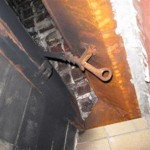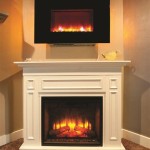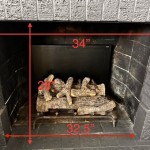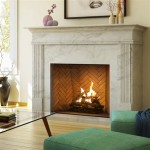Gas Fireplace Draft: Causes, Identification, and Solutions
A gas fireplace is designed as a convenient and aesthetically pleasing heating solution. However, experiencing a draft emanating from the fireplace when it is not in operation can be a significant problem. This draft not only negates potential energy savings but also indicates underlying issues that need addressing. Understanding the causes of a gas fireplace draft, properly identifying the source, and implementing effective solutions are crucial for maintaining a comfortable and energy-efficient home.
A draft occurs when air from outside the home flows down the chimney or vent and into the living space. This unwanted airflow can be caused by a variety of factors, ranging from pressure imbalances within the house to issues with the fireplace’s venting system itself. Leaving the problem unaddressed can lead to increased heating bills, uncomfortable room temperatures, and potential safety concerns.
Understanding the Stack Effect and its Impact
The stack effect, also known as the chimney effect, is a fundamental principle that contributes to drafts in gas fireplaces. Warm air naturally rises. In a house, the warm air inside is generally less dense than the cold air outside, especially during the winter months. This density difference creates a pressure difference, driving the warm air upwards and out through any available opening, including the chimney and vent of a gas fireplace.
As warm air rises and escapes, it creates a negative pressure at the lower levels of the house. This negative pressure then draws in cold air from outside to replace the escaping warm air. This incoming air can enter through cracks in doors and windows, poorly insulated areas, and, most notably, the fireplace. The taller the chimney or vent stack, the greater the potential for a strong stack effect. This phenomenon is more pronounced in multi-story homes.
The stack effect is not solely dependent on outdoor temperature. Internal factors within the house, such as forced-air heating systems, can exacerbate the effect. When a furnace is running, it heats the air and forces it into the living spaces, further contributing to the upward movement of warm air and increasing the negative pressure at lower levels.
Identifying the Source of the Gas Fireplace Draft
Correctly identifying the source of the draft is paramount to implementing effective solutions. The first step involves confirming that the draft originates from the gas fireplace itself. This can be done by holding a lit candle or a smoke pencil near the fireplace opening when the unit is not operating. If the flame or smoke is drawn towards the opening, it confirms the presence of a draft.
Once the fireplace is identified as the source, further investigation is required to pinpoint the underlying cause. Check the fireplace damper, if equipped, to ensure it is fully closed. Even a slightly ajar damper can allow significant airflow. Examine the vent pipe or chimney for any signs of damage, such as cracks or gaps, which could be allowing air to enter the system. Inspect the connection points between the fireplace and the vent pipe or chimney for proper sealing.
Consider the overall pressure balance within the house. Are there other appliances, such as kitchen exhaust fans or bathroom fans, that are frequently used? These appliances can create negative pressure within the house, intensifying the draft from the fireplace. Observe the operation of these appliances in conjunction with the fireplace to determine if there is a correlation.
Furthermore, assess the insulation surrounding the fireplace. Inadequate insulation can allow cold air to penetrate the walls and contribute to the draft. Inspect the area around the fireplace for any gaps or cracks that need to be sealed.
Implementing Solutions to Eliminate Gas Fireplace Drafts
Addressing gas fireplace drafts requires a multi-faceted approach that considers the underlying causes and the specific characteristics of the fireplace and the home. The following solutions address common causes and provide effective methods for eliminating unwanted airflow.
Sealing Air Leaks: The first step in mitigating gas fireplace drafts involves sealing any potential air leaks in the fireplace and surrounding areas. This includes sealing gaps around the fireplace opening with caulk or weather stripping. Pay particular attention to the connection points between the fireplace and the vent pipe or chimney. Use high-temperature sealant designed for fireplace applications to ensure a durable and effective seal.
Installing a Fireplace Damper or Flue Blocker: For gas fireplaces that utilize a traditional chimney, ensuring a properly functioning damper is crucial. If the existing damper is damaged or ineffective, consider replacing it with a new damper that provides a tight seal. In cases where a damper is not present or is difficult to repair, a flue blocker can be installed. A flue blocker is an inflatable or mechanically secured device that seals the chimney when the fireplace is not in use, preventing airflow. Ensure the flue blocker is compatible with gas fireplaces and installed according to the manufacturer's instructions.
Addressing Pressure Imbalances: Mitigating the stack effect and other pressure imbalances within the house can significantly reduce gas fireplace drafts. Consider installing a fresh air intake for the furnace. This allows the furnace to draw air from outside, rather than from the interior of the house, reducing the negative pressure. Avoid excessive use of exhaust fans, particularly in conjunction with the fireplace. When using exhaust fans, crack a window slightly to allow air to enter the house and reduce negative pressure.
Improving Insulation: Enhancing the insulation around the fireplace can help to minimize heat loss and reduce drafts. Insulate any accessible areas around the fireplace, such as the walls and ceiling of the chase (the enclosure housing the chimney or vent pipe). Use fire-resistant insulation materials that are specifically designed for fireplace applications. Ensure that the insulation is installed properly to avoid any gaps or compressed areas that could reduce its effectiveness.
Considering a Direct-Vent Fireplace Upgrade: For homeowners experiencing persistent and unresolved draft issues with their existing gas fireplace, upgrading to a direct-vent fireplace may be an effective long-term solution. Direct-vent fireplaces draw combustion air from outside the house and vent exhaust gases directly to the exterior through a sealed system. This eliminates the need for a traditional chimney and prevents the stack effect from affecting the fireplace. Direct-vent fireplaces are also generally more energy-efficient than traditional fireplaces.
Professional Inspection: If drafts persist despite implementing these solutions, a professional inspection by a qualified HVAC technician or chimney sweep is recommended. A professional can thoroughly assess the fireplace and venting system, identify any hidden issues, and recommend appropriate solutions.
Addressing a gas fireplace draft is essential for maintaining a comfortable and energy-efficient home. Understanding the causes of the draft, properly identifying the source, and implementing appropriate solutions are crucial steps in resolving the problem. Implementing effective solutions can significantly improve home comfort and reduce energy consumption.

Fireplace Cover To Keep Cold Air Out

Stop Cold Air From Wood Or Gas Fireplace

How To Stop Fireplace Drafts Seal A Opening Cold Air Coming From

How To Stop Fireplace Drafts Full Service Chimney

Our Gas Fireplace Is So Drafty It S Like An Open Window Floor Roof House Remodeling Decorating Construction Energy Use Kitchen Bathroom Bedroom Building Rooms City Data Forum

Direct Vent Vs Natural Www Mygasfireplacerepair Com

What Are The Best Ways To Vent A Gas Fireplace Zoroast

Magnetic Fireplace Vent Covers Draft Stopper Cover

Natural Draft Direct Vent Lopi Fireplaces

Gas Fireplace Draft
Related Posts








